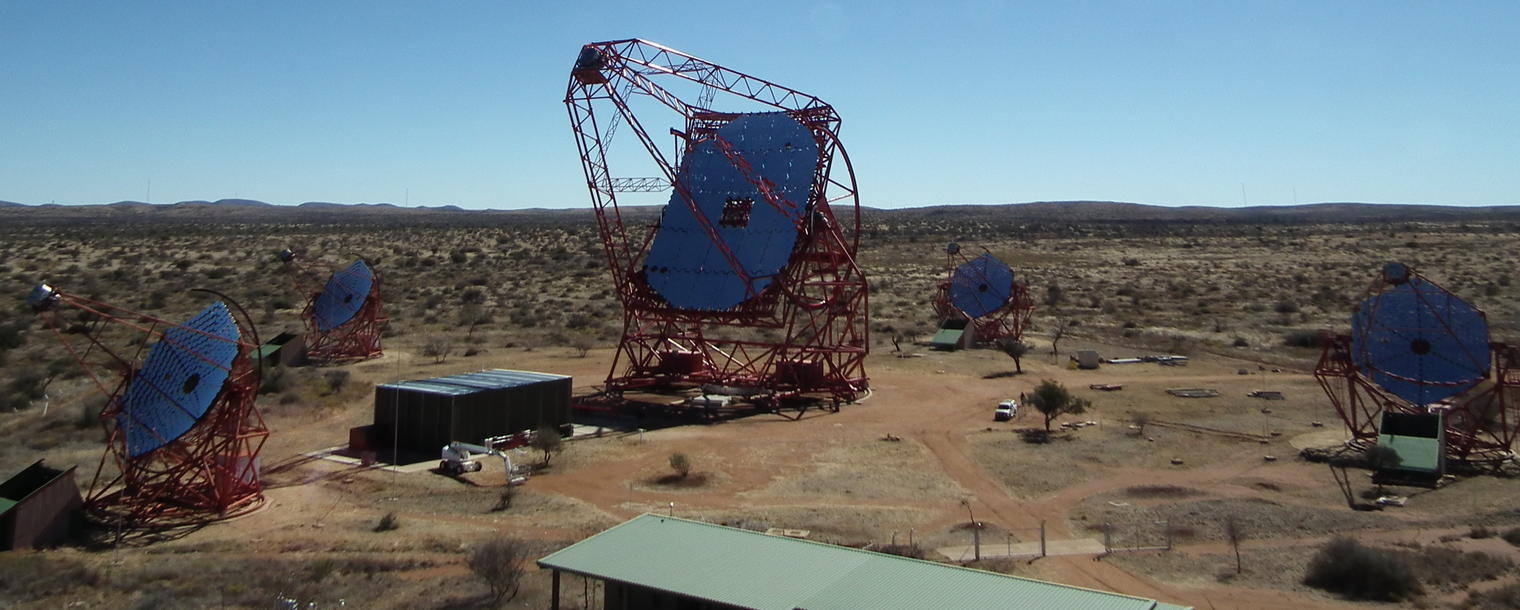
Home
Research/Interests
CV/CareerSummary
HESS (Adel. Internal)
High Energy Astro. Group (Adelaide)

interested in any of these
topics or projects
Gamma-Ray photons represent the highest-energy electromagnetic radiation produced in
nature. Low energy gamma-rays, from about 0.5 MeV up to several 10's of GeV
can be detected directly from space-based instruments such as EGRET and now with Fermi-LAT.
Ground-based methods come into play at higher energies, and have been highly successful in
detecting gamma-rays from about 0.1 GeV up to several 10's of TeV (ground-based methods can
in fact operate down to a few GeV).
The study of TeV gamma-rays is motivated by our desire to understand where and how particle
acceleration is taking place in extreme astrophysical environments. These accelerated particles comprise
cosmic-rays (protons, nuclei) and electrons, and they can have fundametal roles in the evolution of galaxies
and stars. However the charged nature of cosmic-rays and electrons makes them impossible to trace with direct measurements on
Earth unless we go to extreme energies above 1,000,000 TeV where projects such as the Pierre Auger Observatory
is making a big impact.
Gamma-rays however are a highly accessible tracer of multi-TeV particle acceleration in the Universe, and the use of gamma-ray telescopes
such as HESS described below form the backbone of my research interests today. Typical examples of extreme environments where particles
may be accelerated include supernove remnants, rotation-powered pulsar wind-nebulae, stellar assocations and sources with relativistic jet outflows
such as microquasars and the central regions of active galaxies.
HESS-II (the High Energy Stereoscopic System) is an array of four identical telescopes and one larger telescope located in Namibia (22deg South) that
image the Cherenkov radiation from extensive air shower (EAS) particles generated when a gamma-ray
enters and interacts with the Earth's atmosphere. The development of HESS draws on the experience gained from
previous telescopes, in particular the HEGRA CT-System which first demonstrated the potential of
stereoscopic observations. HESS-II has now opened up the field of TeV gamma-ray astronomy, discovering the bulk of the ~100
TeV sources known today. The new 28 metre diameter fifth telescope at the middle was added in late 2012 and will lower the
threshold down to <50 GeV.
The picture to the left shows the HESS-II telescope array from above.
More details concerning HESS-II can be found at the HESS Collaboration website.
An outreach poster on HESS-II and gamma-ray astronomy designed for our University Open Days is available here
This recent article on HESS-II appeared in the Faculty of Sciences' E-Science magazine.
A glossy brochure with more details of HESS science can be found here
Complementing TeV gamma-ray astronomy is the study of the interstellar medium (ISM). The molecular gas throughout the galaxy is particularly important as spatial mapping of such gas can greatly help in understanding whether or not gamma-ray sources result from accelerated electrons or cosmic-rays (protons and nuclei). This then feeds back in helping to answer long-standing questions concerning the origin of cosmic-rays, how they propagate in and through the ISM, magnetic fields in the ISM, and what type of extreme scenarios actually accelerate particles to multi-TeV energies. Additional motivation comes from the fact that over 30% of the Galactic TeV gamma-ray sources are unidentified, sparking increased observations in other wavebands. As a result, much of my research is devoted to observations of TeV gamma-ray sources at millimetre and sub-millimetre wavelengths with telescopes such as Mopra in NSW and Nanten/Nanten2 on the Atacama high plateau (5km a.s.l) in Chile. Results of our Mopra observations are catalogued here on our Mopra Gamma-Ray Sources Survey page.
Here is a brief list of the sources I and my students have studied or are studying with HESS, HEGRA, CANGAROO, Nanten, Mopra,
and other instruments such as XMM-Newton and Chandra (X-rays):
- Centaurus A (the closest active galaxy)
- TeVJ2032+4130 (the first-known unidentifed TeV gamma-ray source)
- HESSJ1303-631 (The first HESS-discovered unidentifed TeV source)
- Westerlund1 (Massive stellar cluster with Wolf-Rayet members)
- W28 (an old-age SNR with molecular cloud interaction)
- RXJ1713.7-3946 (young SNR with non-thermal X-ray emission)
- SS-433 (galactic jet source interacting with the surrounding ISM)
- LS5039 (High Mass X-ray binary with orbital modulation in its TeV gamma-ray emission)
- Magnetars (soft gamma repeaters and anomolous X-ray pulsars)
- Unidentified TeV sources (a rapidly growing list)
A major area of interest is the study of high energy sources at E>10 TeV energies, an energy range
not adequately covered by existing intruments such as HESS. Our group is working on the concept of
a new array of small (10-30 m^2 dishes -- HESS dishes are about 100 m^2) gamma-ray telescopes optimised
for this purpose - called PeX (PeV eXplorer) and TenTen (for 10km^3 above 10 TeV energies).
Further details and motivation of this project can be found at this
page, which details a workshop we organised for this idea.
Our Japanese colleague (T. Yoshikoshi, Uni. Tokyo) also has a webpage
(sorry in Japanese only - English available soon) dedicated to PeX. Such an array will be realised as a part of the much larger
Cherenkov Telescope Array (CTA) which aims to cover the ~20 GeV to ~100 TeV energy range with
a combination of over ~100 telescopes. I lead the Australian consortium of six institutes that has recently joined CTA via an ARC LIEF grant.
Key information about transient/variable high energy sources can come from their activity states at other
wavelengths. Of high interest is the use of optical and radio telescopes to monitor Galactic transient
sources such as X-ray binaries, SGR (soft-gamma-repeaters), AXP (anomalous X-ray pulsars)
with a view to establishing trends in their multiwavelength output -- and to trigger TeV
gamma-ray observations. Here, future radio telescopes in Australia such as MWA and ASKAP will greatly enhance
our understanding of the transient radio sky, leading into potential insights into high energy emission.